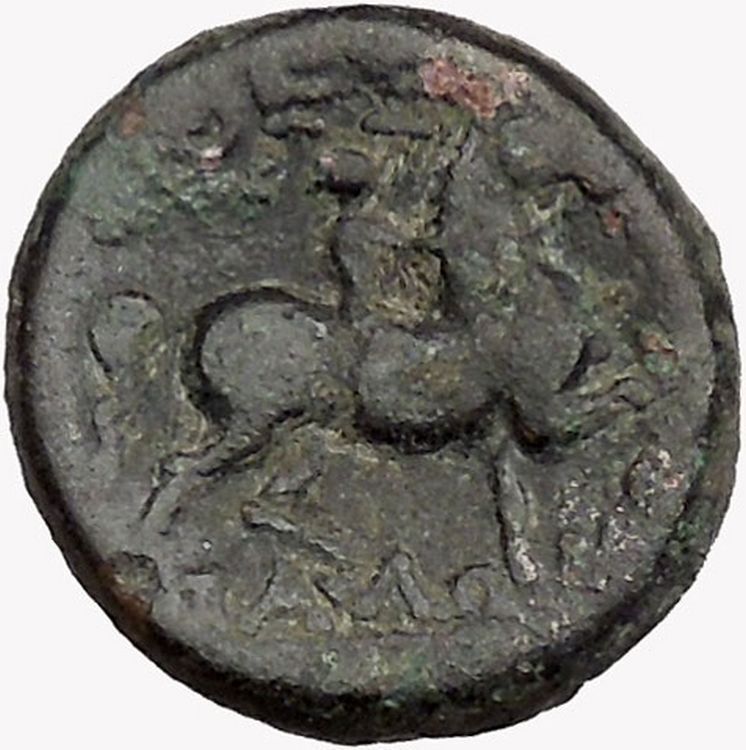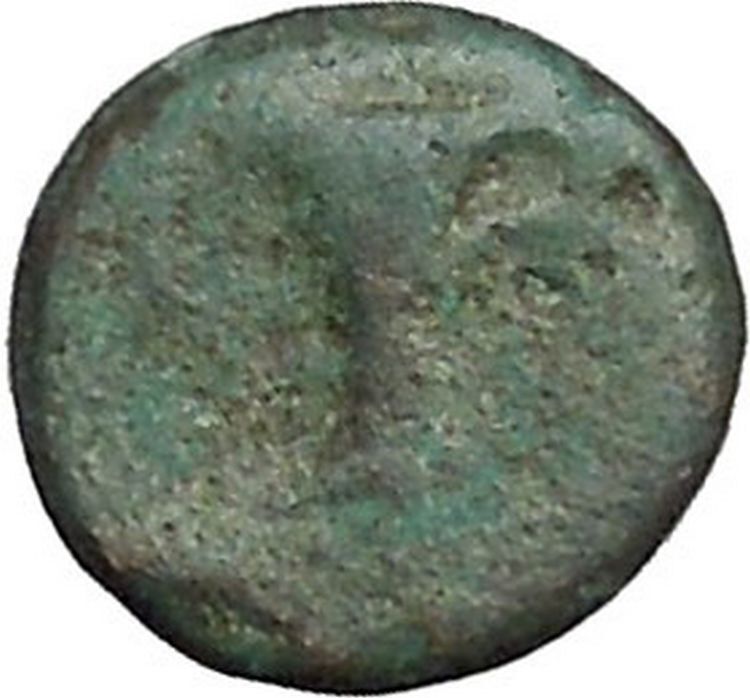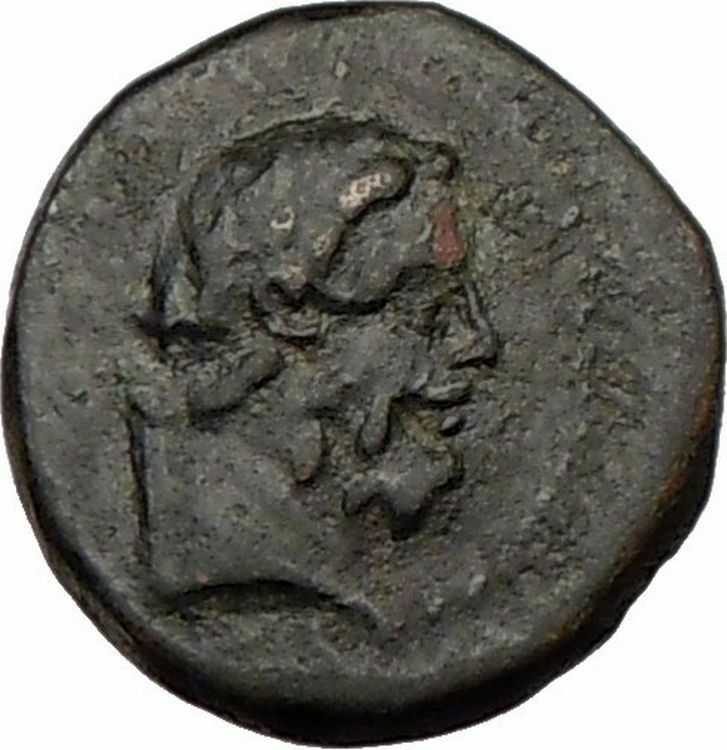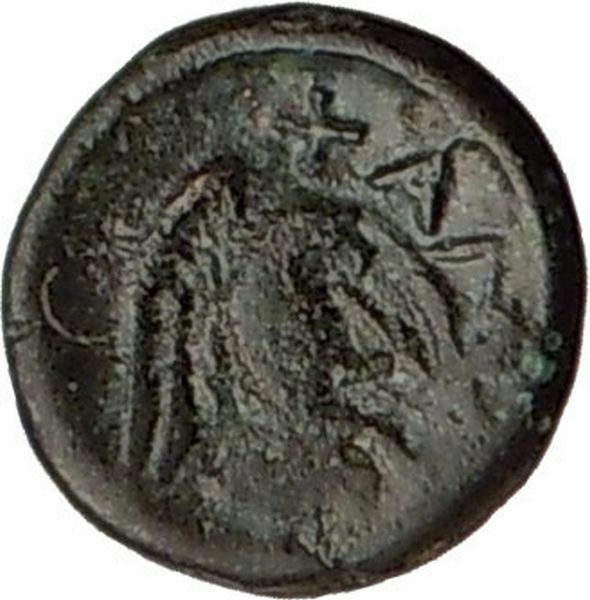|
Greek city of Athens in Attica Greece
Bronze 22mm (4.32
grams) Struck 264-267 A.D..
Reference: Agora 172; BMC 684
Draped bust of
Athena right, wearing crested Corinthian helmet.
AΘHN-A-IΩN, Athena standing
facing, head left, holding spear in right hand, shield on left arm.
References: Kroll 318; Svoronos pl. 86, 7 (same obverse die); SNG Copenhagen
391-392; BMC Attica pg. 93, 676-678; Laffaille -; Imhoof-Blumer (op. cit.), pl.
Z, Athens II, i-ii.
The most famous of all Greek statues, Athena Promachos on the Acropolis by
Pheidias, was seen and described by Pausanias (I.28, 20) “…. it was the work
of Pheidias but reliefs upon the shield, including the fight between Cetaurs and
Lapithae, are said to be from the chisel of Mys, for whom they say Parrhasius,
the son of Evenor, designed this and the rest of his work. The point of the
spear of this Athena and the crest of her helmet are visible to those sailing to
Athens, as soon as Sunium is passed.”
You are bidding on the exact item pictured,
provided with a Certificate of Authenticity and Lifetime Guarantee of
Authenticity.
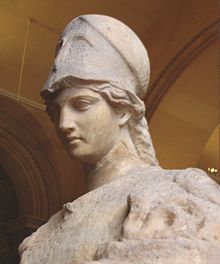
Helmeted Athena with the cista and Erichthonius in his serpent form.
Roman, first century (Louvre
Museum)
In
Greek religion
and
mythology
, Athena or Athene, also
referred to as Pallas Athena/Athene , is the goddess of wisdom, courage,
inspiration, civilization, law and justice, just warfare, mathematics, strength,
strategy, the arts, crafts, and skill.
Minerva
is the
Roman goddess
identified with
Athena.
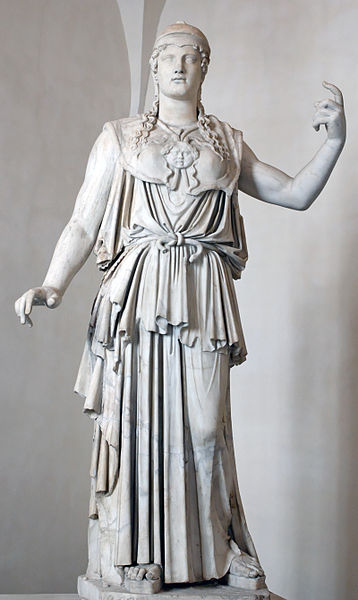
Athena is also a shrewd companion of
heroes and is the
goddess
of heroic endeavour. She is the
virgin
patroness of
Athens
. The Athenians founded the
Parthenon
on the Acropolis of her namesake
city, Athens (Athena Parthenos), in her honour.
Athena’s veneration as the patron of Athens seems to have existed from the
earliest times, and was so persistent that archaic myths about her were recast
to adapt to cultural changes. In her role as a protector of the city (polis),
many people throughout the Greek world worshiped Athena as Athena Polias
(Ἀθηνᾶ Πολιάς “Athena of the city”). The city of
Athens
and the goddess Athena essentially bear
the same name, “Athenai” meaning “[many] Athenas”.
Patroness

Athenian
tetradrachm
representing the
goddess Athena
Athena as the goddess of philosophy became an aspect of the cult in Classical
Greece during the late 5th century B.C. She is the patroness of various crafts,
especially of weaving
, as Athena Ergane, and was
honored as such at festivals such as
Chalceia
. The metalwork of weapons also fell
under her patronage. She led battles (Athena
Promachos or the warrior maiden Athena Parthenos) as the
disciplined, strategic side of war, in contrast to her brother
Ares, the patron of violence, bloodlust and slaughter—”the raw force
of war”. Athena’s wisdom includes the cunning intelligence (metis) of
such figures as Odysseus
. Not only was this version of Athena
the opposite of Ares in combat, it was also the polar opposite of the serene
earth goddess version of the deity, Athena Polias.
Athena appears in Greek mythology as the patron and helper of many heroes,
including Odysseus
,
Jason
, and
Heracles
. In
Classical Greek
myths, she never consorts with
a lover, nor does she ever marry,earning the title Athena Parthenos. A
remnant of archaic myth depicts her as the adoptive mother of
Erechtheus
/Erichthonius
through the foiled rape by
Hephaestus
. Other variants relate that
Erichthonius, the serpent that accompanied Athena, was born to
Gaia
: when the rape failed, the semen landed on
Gaia and impregnated her. After Erechthonius was born, Gaia gave him to Athena.
Though Athena is a goddess of war strategy, she disliked fighting without
purpose and preferred to use wisdom to settle predicaments.The goddess only
encouraged fighting for a reasonable cause or to resolve conflict. As patron of
Athens she fought in the Trojan war on the side of the Achaeans.
Mythology
Lady of Athens
Athena competed with
Poseidon
to be the patron deity of Athens,
which was yet unnamed, in a version of one
founding myth
. They agreed that each would give
the Athenians one gift and that the Athenians would choose the gift they
preferred. Poseidon struck the ground with his
trident
and a salt water spring sprang up; this
gave them a means of trade and water—Athens at its height was a significant sea
power, defeating the
Persian
fleet at the
Battle of Salamis
—but the water was salty and
not very good for drinking.
Athena, however, offered them the first domesticated
olive tree
. The Athenians (or their king,
Cecrops
) accepted the olive tree and with it
the patronage of Athena, for the olive tree brought wood, oil, and food.
Robert Graves
was of the opinion that
“Poseidon’s attempts to take possession of certain cities are political myths”
which reflect the conflict between matriarchal and patriarchal religions.
Other sites of cult
Athena also was the patron goddess of several other Greek cities, notably
Sparta, where the archaic cult of
Athena Alea
had its sanctuaries in the
surrounding villages of
Mantineia
and, notably,
Tegea
. In Sparta itself, the temple of Athena
Khalkíoikos (Athena “of the Brazen House”, often
latinized
as Chalcioecus) was the
grandest and located on the Spartan acropolis; presumably it had a roof of
bronze. The forecourt of the Brazen House was the place where the most solemn
religious functions in Sparta took place.
Tegea was an important religious center of ancient Greece, containing the
Temple of Athena Alea
. The temenos was founded by
Aleus
,
Pausanias
was informed. Votive bronzes at the
site from the Geometric and Archaic periods take the forms of horses and deer;
there are
sealstone
and
fibulae
. In the Archaic period the nine
villages that underlie Tegea banded together in a
synoecism
to form one city. Tegea was listed in
Homer
‘s
Catalogue of Ships
as one of the cities that
contributed ships and men for the
Achaean assault on Troy
.
Judgment of Paris

Aphrodite is being surveyed by Paris, while Athena (the leftmost
figure) and Hera stand nearby.
El Juicio de Paris
by
Enrique Simonet
, ca. 1904
All the gods and goddesses as well as various mortals were invited to the
marriage of Peleus
and
Thetis
(the eventual parents of
Achilles
). Only
Eris
, goddess of discord, was not invited. She
was annoyed at this, so she arrived with a golden apple inscribed with the word
καλλίστῃ (kallistēi, “for the fairest”), which she threw among the goddesses.
Aphrodite, Hera, and Athena all claimed to be the fairest, and thus the rightful
owner of the apple.
The goddesses chose to place the matter before Zeus, who, not wanting to
favor one of the goddesses, put the choice into the hands of Paris, a
Trojan prince. After bathing in the spring of
Mount Ida
(where Troy was situated), the
goddesses appeared before Paris. The goddesses undressed and presented
themselves to Paris naked, either at his request or for the sake of winning.

Paris is awarding the apple to Aphrodite, while Athena makes a face.
Urteil des Paris by
Anton Raphael Mengs
, ca. 1757
Still, Paris could not decide, as all three were ideally beautiful, so they
resorted to bribes. Hera tried to bribe Paris with control over all
Asia and Europe
, while Athena offered wisdom, fame and
glory in battle, but Aphrodite came forth and whispered to Paris that if he were
to choose her as the fairest he would have the most beautiful mortal woman in
the world as a wife, and he accordingly chose her. This woman was
Helen
, who was, unfortunately for Paris,
already married to King
Menelaus
of
Sparta
. The other two goddesses were enraged by
this and through Helen’s abduction by Paris they brought about the
Trojan War
.

The Parthenon
, Temple of Athena
Parthenos
Masculinity and
feminism
Athena had an “androgynous compromise” that allowed her traits and what she
stood for to be attributed to male and female rulers alike over the course of
history (such as Marie de’ Medici, Anne of Austria, Christina of Sweden, and
Catherine the Great)
J.J. Bachofen advocated that Athena was originally a maternal figure stable
in her security and poise but was caught up and perverted by a patriarchal
society; this was especially the case in Athens. The goddess adapted but could
very easily be seen as a god. He viewed it as “motherless paternity in the place
of fatherless maternity” where once altered, Athena’s character was to be
crystallized as that of a patriarch.
Whereas Bachofen saw the switch to paternity on Athena’s behalf as an
increase of power, Freud on the contrary perceived Athena as an “original mother
goddess divested of her power”. In this interpretation, Athena was demoted to be
only Zeus’s daughter, never allowed the expression of motherhood. Still more
different from Bachofen’s perspective is the lack of role permanency in Freud’s
view: Freud held that time and differing cultures would mold Athena to stand for
what was necessary to them.
Athens,
the
capital
and largest city of
Greece
,
dominates the
Attica
periphery; as one of the
world’s oldest cities
, its
recorded history
spans around 3,400 years.
The Greek capital has a population of 745,514 (in 2001)
within its administrative limits
and a land area of 39 km2 (15 sq mi).
The urban
area
of Athens extends beyond the administrative
city
limits
with a population of 3,130,841 (in 2001)
and a land area of 412 km2 (159 sq mi).
According to Eurostat
, the Athens
Larger Urban Zone
(LUZ) is the 7th most populous LUZ in the
European Union
(the 5th most populous capital city of the
EU
) with a population of 4,013,368 (in 2004).
A bustling and cosmopolitan metropolis, Athens is central to economic,
financial, industrial, political and cultural life in Greece and it is rated as
an alpha-
world city
.
It is rapidly becoming a leading business centre in the European Union. In 2008,
Athens was ranked the world’s 32nd richest city by purchasing power
and the
25th most expensive
in a UBS
study.
Classical Athens
was a powerful
city-state
.
A centre for the arts, learning and
philosophy
,
home of Plato
‘s
Academy
and
Aristotle
‘s
Lyceum
,
Athens was also the birthplace of
Socrates
,
Pericles
,
Sophocles
and its many other prominent philosophers, writers and politicians of the
ancient world
. It is widely referred to as the
cradle
of Western civilization and the birthplace of
democracy
,
largely due to the impact of its cultural and political achievements during the
5th and 4th centuries BC on the rest of the then known
European continent
.
The heritage of the
classical era
is still evident in the city, represented by a number of
ancient monuments
and works of art, the most famous of all being the
Parthenon
on the
Acropolis
, widely considered a key landmark of early
Western civilization
. The city also retains a vast variety of
Roman
and
Byzantine
monuments, as well as a smaller number of remaining
Ottoman
monuments projecting the city’s long history across the centuries.
Landmarks of the modern era are also present, dating back to 1830 (the
establishment of the independent Greek state), and taking in the
Hellenic Parliament
(19th century) and the Athens Trilogy consisting of the
National Library of Greece
, the
Athens University
and the
Academy of Athens
. Athens was the host city of the
first modern-day Olympic Games
in 1896, and 108 years later it welcomed home
the
2004 Summer Olympics
.

Acropolis of Athens
with the
Parthenon
on top.
The history of
Ancient Greek
coinage can be divided (along
with most other Greek art forms) into four periods, the
Archaic
, the
Classical
, the
Hellenistic
and the
Roman
. The Archaic period extends from the
introduction of coinage to the Greek world during the
7th century BC
until the
Persian Wars
in about 480 BC. The Classical
period then began, and lasted until the conquests of
Alexander the Great
in about 330 BC, which
began the Hellenistic period, extending until the
Roman
absorption of the Greek world in the 1st
century BC. The Greek cities continued to produce their own coins for several
more centuries under Roman rule. The coins produced during this period are
called
Roman provincial coins
or Greek Imperial Coins.
Ancient Greek coins of all four periods span over a period of more than ten
centuries.
Weight
standards and denominations

Above: Six rod-shaped obeloi (oboloi) displayed at the
Numismatic Museum of Athens
,
discovered at
Heraion of Argos
. Below: grasp[1]
of six oboloi forming one drachma

Electrum
coin from
Ephesus
, 620-600 BC, known as
Phanes’ coin
. Obverse:
Stag
grazing, ΦΑΝΕΩΣ (retrograde).
Reverse: Two incuse punches.
The basic standards of the Ancient Greek monetary system were the
Attic
standard, based on the Athenian
drachma
of 4.3 grams of silver and the
Corinthian
standard based on the
stater
of 8.6 grams of silver, that was
subdivided into three silver drachmas of 2.9 grams. The word
drachm
(a) means “a handful”, literally “a
grasp”. Drachmae were divided into six
obols
(from the Greek word for a
spit
), and six spits made a “handful”. This
suggests that before coinage came to be used in Greece, spits in
prehistoric times
were used as measures of
daily transaction. In archaic/pre-numismatic times iron was valued for making
durable tools and weapons, and its casting in spit form may have actually
represented a form of transportable
bullion
, which eventually became bulky and
inconvenient after the adoption of precious metals. Because of this very aspect,
Spartan
legislation famously forbade issuance
of Spartan coin, and enforced the continued use of iron spits so as to
discourage avarice and the hoarding of wealth. In addition to its original
meaning (which also gave the
euphemistic
diminutive
“obelisk“,
“little spit”), the word obol (ὀβολός, obolós, or ὀβελός,
obelós) was retained as a Greek word for coins of small value, still used as
such in Modern Greek
slang (όβολα, óvola,
“monies”).
The obol was further subdivided into tetartemorioi (singular
tetartemorion) which represented 1/4 of an obol, or 1/24 of a drachm. This
coin (which was known to have been struck in
Athens
,
Colophon
, and several other cities) is
mentioned by Aristotle
as the smallest silver coin.:237
Various multiples of this denomination were also struck, including the
trihemitetartemorion (literally three half-tetartemorioi) valued at 3/8 of
an obol.:
| Denominations of silver drachma |
| Image |
Denomination |
Value |
Weight |
|
|
Dekadrachm |
10 drachmas |
43 grams |
|
|
Tetradrachm |
4 drachmas |
17.2 grams |
|
|
Didrachm |
2 drachmas |
8.6 grams |
|
|
Drachma |
6 obols |
4.3 grams |
|
|
Tetrobol |
4 obols |
2.85 grams |
|
|
Triobol (hemidrachm) |
3 obols |
2.15 grams |
|
|
Diobol |
2 obols |
1.43 grams |
|
|
Obol |
4 tetartemorions |
0.72 grams |
|
|
Tritartemorion |
3 tetartemorions |
0.54 grams |
|
|
Hemiobol |
2 tetartemorions |
0.36 grams |
|
|
Trihemitartemorion |
3/2 tetartemorions |
0.27 grams |
|
|
Tetartemorion |
|
0.18 grams |
|
|
Hemitartemorion |
½ tetartemorion |
0.09 grams |
Archaic period
Archaic coinage
Uninscribed
electrum
coin from
Lydia
, 6th century BCE.
Obverse: lion head and sunburst Reverse: plain square
imprints, probably used to standardise weight
Electrum
coin from
Ephesus
, 620-600 BC. Obverse:
Forepart of stag. Reverse: Square incuse punch.
The first coins were issued in either Lydia or Ionia in Asia Minor at some
time before 600 BC, either by the non-Greek Lydians for their own use or perhaps
because Greek mercenaries wanted to be paid in precious metal at the conclusion
of their time of service, and wanted to have their payments marked in a way that
would authenticate them. These coins were made of
electrum
, an alloy of gold and silver that was
highly prized and abundant in that area. By the middle of the 6th century BC,
technology had advanced, making the production of pure gold and silver coins
simpler. Accordingly, King
Croesus
introduced a bi-metallic standard that
allowed for coins of pure gold and pure silver to be struck and traded in the
marketplace.
Coins of Aegina
Silver
stater
of Aegina, 550-530 BC.
Obv.
Sea turtle
with large pellets
down center. Rev. incuse square with eight sections. After the
end of the
Peloponnesian War
, 404 BC, Sea
turtle was replaced by the land
tortoise
.
Silver
drachma
of Aegina, 404-340 BC.
Obverse: Land
tortoise
. Reverse: inscription
AΙΓ[INAΤΟΝ] ([of the] Aeg[inetans]) “Aegina” and dolphin.
The Greek world was divided into more than two thousand self-governing
city-states (in
Greek
, poleis), and more than half of
them issued their own coins. Some coins circulated widely beyond their polis,
indicating that they were being used in inter-city trade; the first example
appears to have been the silver stater or didrachm of
Aegina
that regularly turns up in hoards in
Egypt
and the
Levant
, places which were deficient in silver
supply. As such coins circulated more widely, other cities began to mint coins
to this “Aeginetan” weight standard of (6.1 grams to the drachm), other cities
included their own symbols on the coins. This is not unlike present day
Euro coins, which are recognisably from a particular country, but
usable all over the
Euro zone
.
Athenian coins, however, were struck on the “Attic” standard, with a drachm
equaling 4.3 grams of silver. Over time, Athens’ plentiful supply of silver from
the mines at
Laurion
and its increasing dominance in trade
made this the pre-eminent standard. These coins, known as “owls” because of
their central design feature, were also minted to an extremely tight standard of
purity and weight. This contributed to their success as the premier trade coin
of their era. Tetradrachms on this weight standard continued to be a widely used
coin (often the most widely used) through the classical period. By the time of
Alexander the Great
and his
Hellenistic successors
, this large denomination
was being regularly used to make large payments, or was often saved for
hoarding.
Classical period
A
Syracusan
tetradrachm
(c. 415–405
BC)
Obverse: head of the
nymph
Arethusa
, surrounded by
four swimming
dolphins
and a
rudder
Reverse: a racing
quadriga
, its
charioteer
crowned by the
goddess
Victory
in flight.
Tetradrachm of Athens, (5th century BC)
Obverse: a portrait of
Athena
, patron goddess of
the city, in
helmet
Reverse: the owl of Athens, with an
olive
sprig and the
inscription “ΑΘΕ”, short for ΑΘΕΝΑΙΟΝ, “of the
Athenians
“
The
Classical period
saw Greek coinage reach a high
level of technical and aesthetic quality. Larger cities now produced a range of
fine silver and gold coins, most bearing a portrait of their patron god or
goddess or a legendary hero on one side, and a symbol of the city on the other.
Some coins employed a visual pun: some coins from
Rhodes
featured a
rose, since the Greek word for rose is rhodon. The use of
inscriptions on coins also began, usually the name of the issuing city.
The wealthy cities of Sicily produced some especially fine coins. The large
silver decadrachm (10-drachm) coin from
Syracuse
is regarded by many collectors as the
finest coin produced in the ancient world, perhaps ever. Syracusan issues were
rather standard in their imprints, one side bearing the head of the nymph
Arethusa
and the other usually a victorious
quadriga
. The
tyrants of Syracuse
were fabulously rich, and
part of their
public relations
policy was to fund
quadrigas
for the
Olympic chariot race
, a very expensive
undertaking. As they were often able to finance more than one quadriga at a
time, they were frequent victors in this highly prestigious event.
Syracuse was one of the epicenters of numismatic art during the classical
period. Led by the engravers Kimon and Euainetos, Syracuse produced some of the
finest coin designs of antiquity.
Hellenistic period

Gold 20-stater
of
Eucratides I
, the largest gold coin
ever minted in Antiquity.

Drachma of
Alexandria
, 222-235 AD. Obverse:
Laureate head of
Alexander Severus
, KAI(ΣΑΡ)
MAP(ΚΟΣ) AYP(ΗΛΙΟΣ) ΣЄY(ΑΣΤΟΣ) AΛЄΞANΔPOΣ ЄYΣЄ(ΒΗΣ). Reverse: Bust
of
Asclepius
.
The Hellenistic period was characterized by the spread of Greek
culture across a large part of the known world. Greek-speaking kingdoms were
established in Egypt
and
Syria
, and for a time also in
Iran and as far east as what is now
Afghanistan
and northwestern
India
. Greek traders spread Greek coins across
this vast area, and the new kingdoms soon began to produce their own coins.
Because these kingdoms were much larger and wealthier than the Greek city states
of the classical period, their coins tended to be more mass-produced, as well as
larger, and more frequently in gold. They often lacked the aesthetic delicacy of
coins of the earlier period.
Still, some of the
Greco-Bactrian
coins, and those of their
successors in India, the
Indo-Greeks
, are considered the finest examples
of
Greek numismatic art
with “a nice blend of
realism and idealization”, including the largest coins to be minted in the
Hellenistic world: the largest gold coin was minted by
Eucratides
(reigned 171–145 BC), the largest
silver coin by the Indo-Greek king
Amyntas Nikator
(reigned c. 95–90 BC). The
portraits “show a degree of individuality never matched by the often bland
depictions of their royal contemporaries further West” (Roger Ling, “Greece and
the Hellenistic World”).
The most striking new feature of Hellenistic coins was the use of portraits
of living people, namely of the kings themselves. This practice had begun in
Sicily, but was disapproved of by other Greeks as showing
hubris
(arrogance). But the kings of
Ptolemaic Egypt
and
Seleucid Syria
had no such scruples: having
already awarded themselves with “divine” status, they issued magnificent gold
coins adorned with their own portraits, with the symbols of their state on the
reverse. The names of the kings were frequently inscribed on the coin as well.
This established a pattern for coins which has persisted ever since: a portrait
of the king, usually in profile and striking a heroic pose, on the obverse, with
his name beside him, and a coat of arms or other symbol of state on the reverse.
Minting
All Greek coins were
handmade
, rather than machined as modern coins
are. The design for the obverse was carved (in
incuso
) into a block of bronze or possibly
iron, called a
die
. The design of the reverse was carved into
a similar punch. A blank disk of gold, silver, or electrum was cast in a mold
and then, placed between these two and the punch struck hard with a hammer,
raising the design on both sides of the coin.
Coins as
a symbol of the city-state
Coins of Greek city-states depicted a unique
symbol
or feature, an early form of
emblem
, also known as
badge
in numismatics, that represented their
city and promoted the prestige of their state. Corinthian stater for example
depicted pegasus
the mythological winged stallion, tamed
by their hero
Bellerophon
. Coins of
Ephesus
depicted the
bee
sacred to
Artemis
. Drachmas of Athens depicted the
owl of Athena
. Drachmas of
Aegina
depicted a
chelone
. Coins of
Selinunte
depicted a “selinon” (σέλινον
– celery
). Coins of
Heraclea
depicted
Heracles
. Coins of
Gela depicted a man-headed bull, the personification of the river
Gela
. Coins of
Rhodes
depicted a “rhodon” (ῥόδον[8]
– rose
). Coins of
Knossos
depicted the
labyrinth
or the mythical creature
minotaur
, a symbol of the
Minoan Crete
. Coins of
Melos
depicted a “mēlon” (μήλον –
apple
). Coins of
Thebes
depicted a Boeotian shield.
Corinthian stater with
pegasus
Coin of
Rhodes
with a
rose
Didrachm of
Selinunte
with a
celery
Coin of
Ephesus
with a
bee
Stater of
Olympia
depicting
Nike
Coin of
Melos
with an
apple
Obolus from
Stymphalia
with a
Stymphalian bird
Coin of
Thebes
with a Boeotian shield
Coin of Gela
with a man-headed bull,
the personification of the river
Gela
Didrachm of
Knossos
depicting the
Minotaur
Commemorative coins

Dekadrachm
of
Syracuse
[disambiguation
needed]. Head of Arethusa or queen
Demarete. ΣΥΡΑΚΟΣΙΟΝ (of the Syracusians), around four dolphins
The use of
commemorative coins
to celebrate a victory or
an achievement of the state was a Greek invention. Coins are valuable, durable
and pass through many hands. In an age without newspapers or other mass media,
they were an ideal way of disseminating a political message. The first such coin
was a commemorative decadrachm issued by
Athens
following the Greek victory in the
Persian Wars
. On these coins that were struck
around 480 BC, the owl
of Athens, the goddess
Athena
‘s sacred bird, was depicted facing the
viewer with wings outstretched, holding a spray of olive leaves, the
olive tree
being Athena’s sacred plant and also
a symbol of peace and prosperity. The message was that Athens was powerful and
victorious, but also peace-loving. Another commemorative coin, a silver
dekadrachm known as ” Demareteion”, was minted at
Syracuse
at approximately the same time to
celebrate the defeat of the
Carthaginians
. On the obverse it bears a
portrait of
Arethusa
or queen Demarete.
Ancient Greek coins
today
Collections of Ancient Greek coins are held by museums around the world, of
which the collections of the
British Museum
, the
American Numismatic Society
, and the
Danish National Museum
are considered to be the
finest. The American Numismatic Society collection comprises some 100,000
ancient Greek coins from many regions and mints, from Spain and North Africa to
Afghanistan. To varying degrees, these coins are available for study by
academics and researchers.
There is also an active collector market for Greek coins. Several auction
houses in Europe and the United States specialize in ancient coins (including
Greek) and there is also a large on-line market for such coins.
Hoards of Greek coins are still being found in Europe, Middle East, and North
Africa, and some of the coins in these hoards find their way onto the market.
Coins are the only art form from the Ancient world which is common enough and
durable enough to be within the reach of ordinary collectors.
|


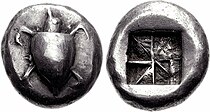





























,_a_Stunning_Depiction_of_Dionysos.jpg/130px-Greek_Silver_Stater_of_Thebes_(Boeotia),_a_Stunning_Depiction_of_Dionysos.jpg)



